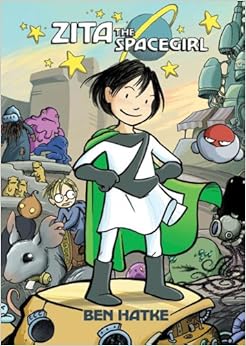Author/Illustrator: Ben Hatke
Awards: 2012 Children's Choice, Texas Bluebonnet
Genre: Graphic Novel
Grade Level: K-4
When Zita and her friend Joseph find a mysterious red button, the curiosity gets the best of them. They push the button and are transported to an alternate universe. Zita finds that Joseph has been captured and is under attack by an unworldly creature. On her journey to save her friend, Zita meets many strange animals and robots and discovers that they are all worried about an asteroid that will soon hit their planet. She happens upon a giant rat, Strong Strong, who she rides to get around, and another human, Piper, who seems to have ulterior motives. Eventually Zita saves her friend Joseph and they return home.
I appreciate the simplicity in these illustrations. The story really comes alive when the alien creatures are seen. The illustrator uses darker colors and creates movement with all of the aliens.
This book is an excellent choice for students who are more interested in the illustrations, or children who do not yet have the reading level to read such a lengthy story. The sci-fi setting and heroic female lead will keep all readers interested and engaged.









